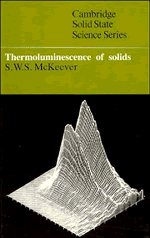Book contents
- Frontmatter
- Contents
- Preface
- 1 Introduction
- 2 Theoretical background
- 3 Thermoluminescence analysis
- 4 Additional factors governing thermoluminescence
- 5 Defects and thermoluminescence
- 6 Thermoluminescence dosimetry (TLD)
- 7 Thermoluminescence dating
- 8 Geological applications
- 9 Instrumentation
- Appendix A Minerals
- Appendix B Commercial thermoluminescence systems
- References
- Index
5 - Defects and thermoluminescence
Published online by Cambridge University Press: 04 April 2011
- Frontmatter
- Contents
- Preface
- 1 Introduction
- 2 Theoretical background
- 3 Thermoluminescence analysis
- 4 Additional factors governing thermoluminescence
- 5 Defects and thermoluminescence
- 6 Thermoluminescence dosimetry (TLD)
- 7 Thermoluminescence dating
- 8 Geological applications
- 9 Instrumentation
- Appendix A Minerals
- Appendix B Commercial thermoluminescence systems
- References
- Index
Summary
General introduction
Among the list of uses for thermoluminescence outlined in chapter 1, the study of the defect structure of materials using this technique is perhaps the most difficult, in that interpretation of the results is not straightforward. In fact, on its own, thermoluminescence is only of limited value in arriving at a true characterization of the defect structure of the solid under study. Greatest benefit can be attained when the technique is used in conjunction with other experimental methods (dielectric loss, electrical conductivity, ITC/TSPC, optical absorption, electron spin resonance, etc.) in which case the information gained can be extremely useful. It should be realized, however, that these different experimental techniques may be sensitive to different types or collections of defects, so that conclusions derived from one method should be applied cautiously to the results obtained from another.
Some areas requiring special caution ought to be noted. The techniques mentioned above are normally used to give information about specific defects. If correlations can be found between various defect concentrations and certain thermoluminescence peaks, then such results are normally used to argue in favour of a particular defect being responsible for a particular peak. However, it is important to remember that thermoluminescence requires two principal defect types – a trap and a luminescent centre. In the techniques listed above it is not known which one, if either, of these defects is being monitored.
- Type
- Chapter
- Information
- Thermoluminescence of Solids , pp. 153 - 204Publisher: Cambridge University PressPrint publication year: 1985
- 3
- Cited by



